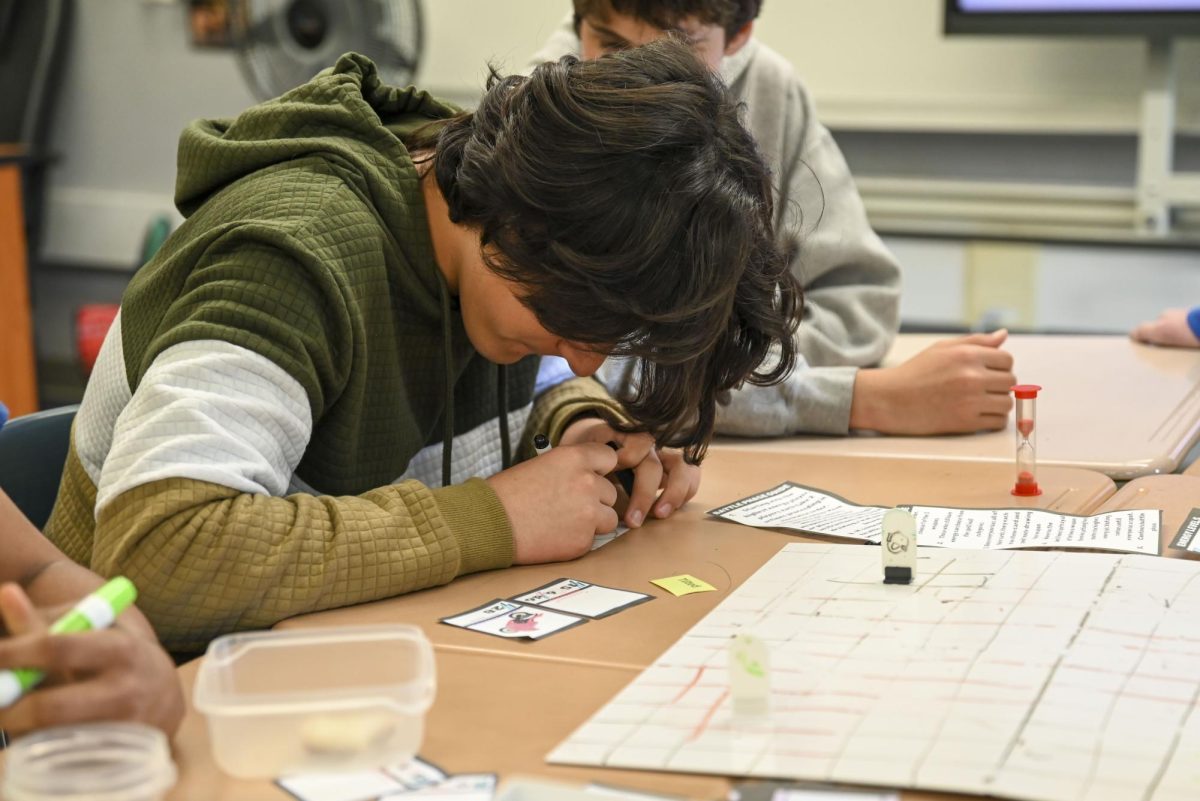A board game about fighting people, while drawing what weapons you’ll use to do just that. That’s what Whiteboard Warfare is, the game that Tabletop Game Design Club submitted to an international competition called Cardboard Edison.
“[Making the game took] a pretty decent chunk of time,” freshman Ollie Genberg said. “Cardboard Edison is definitely one of the bigger competitions we’re doing this year.”
The club members work on their games on Wednesdays and playtest it on Fridays to perfect the game. The club’s goal this year was to enter two competitions a year.
“Right now, we have two to three teams of people, each developing a separate board game that they’re going to submit to a competition,” Genberg said. “One day we had everybody make a small card game like War, but they had to make their own version of it, that was really fun.”
As this is the first year of the club’s existence, not everything has exactly gone according to plan.
“We started trying to make prototypes for a much smaller competition, but the deadline for that was way too quick, as we learned very quickly,” Genberg said.
That didn’t stop them from participating in future competitions, though, as they ended up submitting Whiteboard Warfare to Cardboard Edison later on. The club split into groups, so originally, it wasn’t going to be the only game submitted to the competition, but it was the only game that could be made on time.
“We ended up making a couple prototypes on a game called Robot Uprising. It is what it sounds like, you have to fight against robots. We eventually hit a dead end as we realized there were some fundamental flaws,” Genberg said.
Although the group Genberg is with isn’t working on Robot Uprising anymore, nor did they submit it to Cardboard Edison, they are still planning on making a game.
“As of right now, we’re working on prototypes for a mech building and fighting game,” Genberg said.
Even if Robot Uprising didn’t work out, Whiteboard Warfare got a lot farther, and even though it got submitted to Cardboard Edison, the club is still working on improving their game.
“I think there’s definitely some balancing work to do. But I think other than that, it’s actually a really great game. There aren’t a lot of flaws with the design, [the people working on Whiteboard Warfare] hammered it out really well,” Genberg said.
Balancing refers to making sure aspects of the game are not too overpowered or underpowered. Freshman Cameron Akhavan, president of Tabletop Game Design Club, and one of the members who worked on Whiteboard Warfare, explained this process, and why balancing is necessary to eliminate all errors created during production.
“We had a blow dart that did literally one damage, and it cost way more energy than other stuff,” Akhavan said. “It was stupid, but it takes a lot of playtesting to find all these little errors.”
It took over two months of development for Whiteboard Warfare to reach the point it is at now. Four people created the game, with the entire club helping out and playtesting it. The brainstorming alone took almost two weeks. During this time, they wrote down potential ideas and inspirations.
“We all sat there trying to come up with the ideas, and one person said ‘Oh, what if we made it a chess-like game,’ and then another person said ‘No, no, let’s make pictionary,’ and then a third person said ‘Let’s make a game where you play as a pencil and draw stuff on the board.’ So we wrote down the three ideas and then we got more excited about it and kept on coming up with new rules,” Akhavan said.
From there, they made a draft of the game out of paper and playtested it every Friday until they felt it was “somewhat balanced.”
“The competition due date was getting really close. So we went into Canva and we took all of our cards and made art for them, made it so that it would fit within the bounds of a real card, so that you could print it out,” Akhavan said. “And so we had a real functioning game. We got it, we had it, we had the whiteboard pieces delivered to our house and then printed out the cards ourselves.”
Even though it took time to make the game, in the end, their goal of submitting a game they created to a national competition was still achieved.
“It’s just the creativity, and making a whole game with your friends, it’s hard to describe. It’s just fun,” Akhavan said.
Then, the club filmed and edited a video promoting the game, created the rulebook, and submitted it to the Cardboard Edison competition.
“[The competition] gives feedback to everyone. And the people who run it are board game professionals. Also, a lot of the successful games that have come out of the program are very, very, very well selling,” Akhavan said.
It was revealed in late February how Whiteboard Warfare did in the competition.
“We did not [become a finalist], but honestly, I’m not too bummed about it,” Akhavan said. “Feedback was really the most important part for me.”
Out of the 348 submissions in Cardboard Edison, Whiteboard Warfare was in the top 50 percent in all the categories it was scored in.
“We got very specific feedback from all five judges. I was surprised, because [it was said that] feedback would be here by the end of March, but we got ours early,” Akhavan said.
Tabletop Game Design Club is using this feedback to polish the game to ensure they score the highest they can in future competitions.
“We need to make the game either more complicated for the people who like the battle part, or more simple for the people who like the drawing part”, Akhavan said. “We’re leaning towards the simplicity, but we wrote down a whole bunch of ideas to make the game different, but still keep its core ideas.”
As for the future, Akhavan is planning to keep the club running.
“[The club is] still relatively small, so I’d love to see it grow, especially when I become an upperclassman,” Akhavan said. “We might resubmit Whiteboard Warfare or make a new game. But no matter what, we’re going to keep on polishing these games until they’re the best they can be.”



